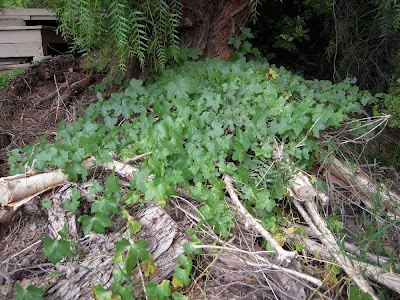
Ferocactus viridescens
var. viridescens
overlooking the Pacific at Torrey Pines State Reserve. Apart from the Crassulaceae (stonecrop family), the Cactaceae (cactus family) is probably the group of succulent plants that is most prominent in the flora of the San Diego area. The most frequently encountered cacti are Opuntia and Cylindropuntia species, the prickly pears and chollas. There are several species of each genus in the area, ready to stick unwary hikers with barbed spines and glochids. Some, like Opuntia littoralis, form impressive spiky clumps.

Opuntia littoralis among spring wildflowers at Torrey Pines.
Ferocactus viridescens looks a little out of place in the chaparral of the coastal regions; the genus is much more widespread in true desert, inland. This small barrel cactus grows mostly on open gravelly slopes, though I spotted a few plants under the scrubby vegetation that dominates the area. Ferocactus viridescens seems to be relatively rare, and getting more so: a botanist told me about a large population in downtown San Diego that persisted for many years on a steep slope amid the parking lots and hotel complexes, which was just recently wiped out by development.
The cactus genera Mammillaria and Bergerocactus are also represented in coastal SoCal, though I’ve never spotted them in the wild. The local climate is almost entirely winter-rainfall, and it seems like the native cacti in the area grow and flower mainly in the cooler part of spring. I suspect that they would do most of their growing in the summer sun if cultivated in a greenhouse in the Northeast, but it would be worth experimenting with keeping them active in the winter.

Yucca shidigera at Torrey Pines.
Yucca and related genera Hesperoyucca and Agave (family Agavaceae) are also encountered in the patchy remnants of the wilds of greater San Diego. Yucca schidigera, Spanish Dagger, is widespread in the Sonoran and Mohave deserts, as well as the chaparral. It branches from the base and grows into a good-sized shrub, often taller than a person.

Marah macrocarpus in a weedy hedgerow on the agricultural outskirts of Vista, Ca.
Marah macrocarpus, California Manroot, is a caudiciform plant in the squash family (Cucurbitaceae). Marah produces scrambling, leafy vines in the winter and spring, but the interesting part of the plant, from the perspective of the succulent-plant fan, is the massive tuber. In the wild, the tuber stays unseen deep underground, but caudiciform growers can raise their Manroots partially above ground for viewing. So to speak.

Mesembryanthemum crystallinum on the beach. Invasive, but pretty.
Finally, the beaches and freeway medians of Southern California are host to a wide variety of ice plants (family Aizoaceae). Most of these are introduced from South Africa, but at least one species—Carpobrotus aequilaterus (Sour Fig)—is most likely native. Some of the exotic ice plants, including Mesembryanthemum and other species of Carpobrotus, have become invasive weeds, sometimes even encountered in wild areas.

The alien Carpobrotus edulis, grown as a groundcover in Vista, California. The native C. aequilaterus is similar, but with violet flowers.
 The Welwitschia mirabilis plants at UConn produced abundant fully-formed cones for the first time, this past summer. On warm afternoons in midsummer, the mature female cones produced "pollination drops," or droplets of nectar at the end of hair-like extensions of the ovules. The male cones have nectaries, as well, which probably attract insect pollinators in the wild in Namibia.
The Welwitschia mirabilis plants at UConn produced abundant fully-formed cones for the first time, this past summer. On warm afternoons in midsummer, the mature female cones produced "pollination drops," or droplets of nectar at the end of hair-like extensions of the ovules. The male cones have nectaries, as well, which probably attract insect pollinators in the wild in Namibia.





